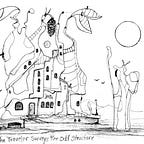How Strong Towns Principles Relate to Sioux Falls — Human Habitat
- based on “Strong Towns — A Bottom-Up Revolution To Rebuild American Prosperity” by Charles L. Marohn, Jr.
“For thousands of years, humans built cities for people who walked.” — Chuck Marohn
One of the most basic observations in Strong Towns philosophy is that the way we have been building cities in North America since the end of WWII is fundamentally different from the way we built cities for thousands of years prior to that. The prior city model was based on walkable designs where the needs of every day life were within walking distance of where you lived. This model was tested and improved upon as needed but basically remained the same for a millennia.
The current development pattern features ever-spreading residential developments on the edge of town which require more and more infrastructure (and money) to maintain. The invention of the automobile supported this type of development and is seen as progress. But is it? Charles Marohn suggests that our current city building model may be the biggest human experiment ever attempted and that many American cities are insolvent because of it. So let’s take a closer look at how this experiment has played out right here in River City. First, let’s look at the time-tested city building model. Come with us for a walk down what may be the best two blocks of Sioux Falls.
Phillips Avenue between 10th to 12th streets was built in the late 1800s and early 1900s without benefit of modern practices like Tax Increment Financing. The buildings are mostly two to three stories and the street width makes the street human scale. That means that people feel comfortable in that space and tend to gather there. Outdoor seating areas are filled all summer long and even on a sunny day in winter people sit out there. It is a very walkable area because with diagonal parking the streets are narrow and drivers go slow. The streets are laid out in a grid pattern so if you can’t find a parking spot right in front of where you want to go, you can go park around the corner and walk to your destination. If you live downtown you can forget the parking issues completely and simply walk to your destination. With the small shops and local businesses in the area, it is a great example of incremental development which we will discuss in future articles.
Now let’s drive to some new development on the edge of town to see how the current model works. It is too far to walk so we have to drive. Look at the houses at the end of a cul de sac. There are no coffee shops, stores or other businesses within walking distance. You have to drive to get to anything. The streets are wide and cars can go fast which makes walking and biking uncomfortable and potentially dangerous. There aren’t many public spaces for people to hang out in. There are studies that show that people can feel isolated in this suburban landscape. This is the development pattern we have been using since WWII and as we will discuss in future articles, it is not sustainable.
The conclusion then is that the historic development model to provide human habitat more closely matches human wants and needs. Our current development model was an abrupt change from what we had been doing and is a big experiment carried out all across North America, including right here in Sioux Falls.
You can purchase Chuck Marohn’s “Strong Towns: A Bottom-Up Revolution to Rebuild American Prosperity” here.
